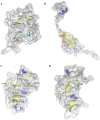Characterization and Expression Analysis of Insulin Growth Factor Binding Proteins (IGFBPs) in Pacific White Shrimp Litopenaeus vannamei
- PMID: 33494370
- PMCID: PMC7866140
- DOI: 10.3390/ijms22031056
Characterization and Expression Analysis of Insulin Growth Factor Binding Proteins (IGFBPs) in Pacific White Shrimp Litopenaeus vannamei
Abstract
The insulin signaling (IIS) pathway plays an important role in the metabolism, growth, development, reproduction, and longevity of an organism. As a key member of the IIS pathway, insulin-like growth factor binding proteins (IGFBPs) are widely distributed a family in invertebrates and vertebrates that are critical in various aspects of physiology. As an important mariculture species, the growth of Pacific white shrimp, Litopenaeus vannamei, is one of the most concerning characteristics in this area of study. In this study, we identified three IGFBP genes in the genome of L. vannamei and analyzed their gene structures, phylogenetics, and expression profiles. LvIGFBP1 was found to contain three domains (the insulin growth factor binding (IB) domain, the Kazal-type serine proteinase inhibitor (Kazal) domain, and the immunoglobulin C-2 (IGc2) domain), while LvIGFBP2 and LvIGFBP3 only contained a single IB domain. LvIGFBP1 exhibited high expression in most tissues and different developmental stages, while LvIGFBP2 and LvIGFBP3 were only slightly expressed in hemocytes. The RNA interference of LvIGFBP1 resulted in a significantly smaller increment of body weight than that of control groups. These results will improve our understanding of the conservative structure and function of IGFBPs and show potential applications for the growth of shrimp.
Keywords: Litopenaeus vannamei; gene expression; gene structures; growth; insulin growth factor binding proteins.
Conflict of interest statement
The authors declare no conflict of interest.
Figures






References
MeSH terms
Substances
LinkOut - more resources
Full Text Sources
Other Literature Sources
Research Materials
Miscellaneous

